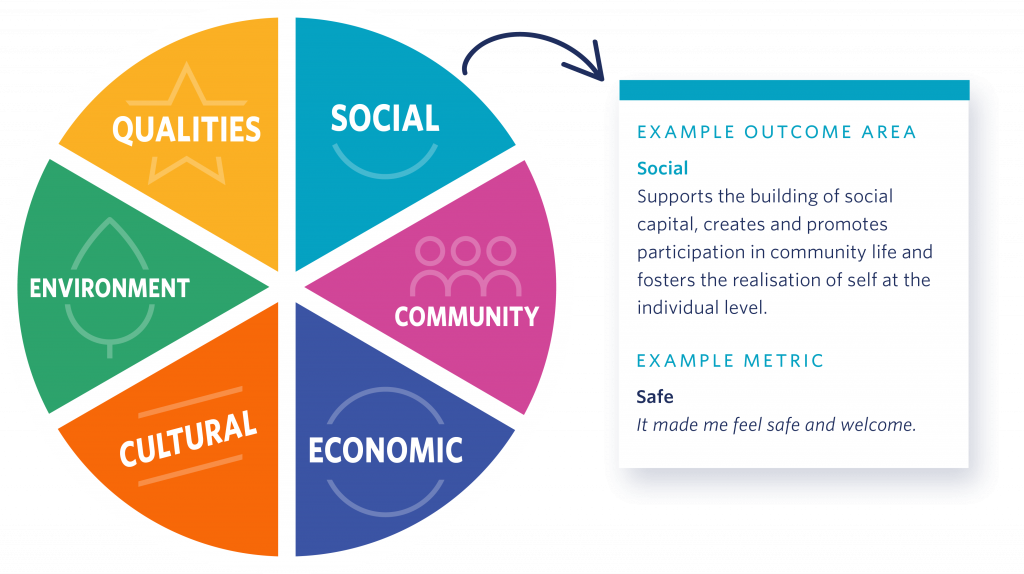When it comes to implementing effective evaluation practices within local government, the number of policies and plans can make the task of creating a consistent evaluation framework seem completely unwieldy. In this article, Business Development Director, Jordan Gibbs explores how Culture Counts approaches the challenge of creating strategic alignments when it comes to local government.
Almost half of Culture Counts users work in the local government sector. That’s no surprise when estimates suggest that local government represents approximately 80% of total government funding for arts and culture in Australia (CDN, 2018). Given the variety of investments made by local government in arts and culture, there are a number of challenges that set them apart from other organisations. Their unique mix of service provision, grant-making, and event delivery creates a flurry of policies and planning to consider. Even more so when it comes to creating a strategically aligned evaluation framework that brings it all together.
The ‘strategic alignment’ is one of our most popular services, but unlike other types of alignments that consider the priorities of multiple stakeholders, local government alignments instead tend to prioritise multiple strategies.
If you’re thinking about creating an evaluation framework for local government, or engaging Culture Counts to assist, these are the four steps we consider when we create a strategic alignment.
Step 1: Document Review
We collect all the documents we need first in a process called a ‘document review’. There are three kinds of documents we look for:
- The Strategic Community Plan: This is the central strategic document for a local government, frequently called the Strategic Community Plan (CPS). These plans tend to be 10-year documents, but are updated at regular intervals throughout their lifespan.
- Sub-Strategies: A CPS shouldn’t be filled with all the detail of a local government, but instead, lay out the broad strokes. Sub-strategies sit within a CPS and fill in the extra detail, aligned back to the overall strategic goals. This is known as a ‘nested’ policy approach.
- Planning Documents: Sometimes sub-strategies contain the plans (i.e. what is local government is actually doing), but sometimes they do not. Strategies are good at explaining the thinking behind planning and decision-making, but sometimes we need a different document that just says clearly what is being done and when.
Step 2: Select an Outcomes Schema
Our next step is to go through these documents and map the alignment between them. If your local government agency has an outcomes framework or a schema it wants to align to, we then map the various goals and strategies in your documents to that schema. Most local governments don’t have a shared outcomes framework though, but that’s okay because we’ve got the perfect one.
The CDN Outcomes Schema is a comprehensive outcomes schema and very appropriate for local government organisations. In 2017, Culture Counts partnered with the Cultural Development Network to integrate its outcomes schema into the Culture Counts Evaluation Platform.
The schema does a great job of listing many of the possible outcomes of cultural activities across five different domains. You can find out more about the schema on the Culture Counts Support Hub or on the CDN website.

Step 3: Map the Outcomes
With an outcomes framework decided, we now go through each document systematically to identify which of the outcomes it is trying to achieve. Not all goals in each strategy will neatly fit into the CDN schemas definition of ‘outcome’, which seeks to measure ‘change’. Some strategic goals are about perceptions or experience. For example:
- We want to be a major events-destination
- We will share local stories about our cultural identity
Goals like this fit neatly into the Quality domain of Culture Counts dimensions, because while they wouldn’t be classified as an ‘outcome’ within a standard Theory of Change or Logic Model, they still hold strategic value as they related to programming and decision-making. The visual below provides an illustration of the document and outcomes mapping process described.

Step 4: Review the Evaluation Framework
So finally, with the documents identified and the outcomes mapped, we can now easily see which measures are the most critical to include in our evaluation framework. This process gives us an opportunity to sense-check our alignment (to see if it contains the correct measures) and the strategic plans (to see if they match our perceptions of the goals we’re trying to achieve).
For example, we might find that a lot of the documents talk about the economic benefits of cultural activity, but fail to articulate the social or cultural values we are looking to foster. Likewise, if we say we want to ‘share local stories’, we might not have described the outcomes that this activity is looking to achieve. Is it social bonding? Are we strengthening our shared identity? Are we learning new things about each other? Is it all of the above?
Sometimes one of the most interesting outcomes of the strategic alignment process is that it invites us to share our personal understanding of the value that we’re creating as a collective. Not only then does a ‘strategic alignment’ give you a systematic account of your documentation and an evaluation framework that aligns with your overall strategy, but it also gives you the chance to share and articulate your unique value as a whole organisation.
“The right questions are the ones that explore data that directly link to our strategic objectives” – John Knell
You can read more about strategic alignments and understanding how shared goals are part of an evaluation framework in John Knell’s blog, or in this article about evaluation planning by Natasha Mian. If you’re thinking about getting a strategic alignment for your organisation, please get in touch.
References:
Cultural Development Network, 2018. ‘Final Report 2018’. National Local Government Cultural Forum.







